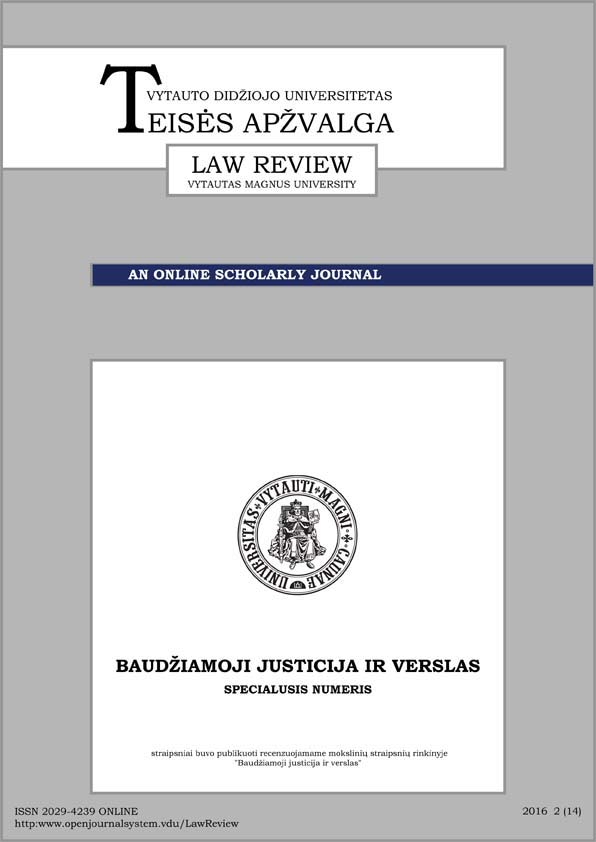Baudžiamoji atsakomybė už svetimo prekių ar paslaugų ženklo naudojimą
Criminal Liability for the Use of Another’s Trademarks or Services Mark
Author(s): Justyna LevonSubject(s): Law, Constitution, Jurisprudence, Criminal Law
Published by: Vytauto Didžiojo Universitetas
Keywords: Criminal law; Criminal liability; The use of another’s trademarks or services mark; Features of corpus delicti; Qualification
Summary/Abstract: Straipsnyje analizuojama baudžiamoji atsakomybė už svetimo prekių ir paslaugų ženklo naudojimą, siekiama ištirti kai kuriuos diskutuotinus BK 204 straipsnio 1 dalyje įtvirtinto nusikaltimo sudėties požymius. Article 23 of the Constitution of the Republic of Lithuania (hereinafter referred to as the Constitution) establishes that property is inviolable and the rights of ownership are protected by laws. This article of the Constitution is also applicable in terms of protection of intellectual property. Objects of intellectual property are categorized in the scientific literature into the following two large groups: 1) copyright and related rights, and 2) industrial design rights. Trademarks of goods and services fall under the category of industrial design rights. Paragraph 1 of Article 204 of the Criminal Code of the Republic of Lithuania (hereinafter referred to as the CC) sets forth as follows: “the one, who without holding an authorisation, identifies a large quantity of goods with another’s trademark or presents them for handling or makes use of another’s service mark and thereby causes major damage shall be punished with a fine, restriction of freedom or imprisonment for a term of up to two years”.It should be noted that even though intellectual property is a popular topic in scientific literature, the number of works analyzing criminal liability for the criminal acts related to intellectual property is considerably scarce in Lithuania. The objective of this article is to analyze the debatable features of crime established in Paragraph 1 of Article 204 of the CC. The article is comprised of several parts. The analysis showed that Article 204 of the CC is one of the most controversial articles of Chapter XXXI. More often than not, the amendments of Article 204 of the CC were triggered by amendments of other articles of the CC or other legal acts.The analysis of the CC raises the question of whether the criminal liability for the use of another’s trademark should rather be regulated in Chapter XXIX of this legal act. Moreover, the title of Chapter XXIX of the CC should be changed. In case of rewording the mentioned Chapter, the interrelation between Article 195 (Violation of Industrial Property Rights) and Article 204 (Use of Another’s Trademark or Service Mark) should also be assessed systematically.A failure to reach a unanimous understanding of what is the object of crime regulated in Paragraph 1 Article 204 of the CC is the reason causing problems in terms of defining the concept of major damage in the sense of Article 204 of the CC. It is recommended to rely on different branches of law to systematically assess the criminal acts regulated in Chapters XXIX and XXXI of the CC. Firstly, the interrelation between Article 195 (Violation of Industrial Property Rights) and Article 204 (Use of Another’s Trademark or Service Mark) of the CC should be determined, and only then the question of the definition of large damage in the sense of Article 204 of the CC should be addressed.The final part of the article discusses the issue of guilt. The criminal acts established in Article 204 of the CC may be committed by either direct or oblique intention. When determining the guilt of the accused, the culpability determination standards prevalent in civil law should not be applied. It is also important not to “forget” about the key principles of criminal law, i.e. presumption of innocence, in dubio pro reo and to keep in mind that criminal law is a measure defined as ultima ratio.
Journal: Teisės apžvalga
- Issue Year: 2016
- Issue No: 2(14)
- Page Range: 229-249
- Page Count: 21
- Language: Lithuanian

